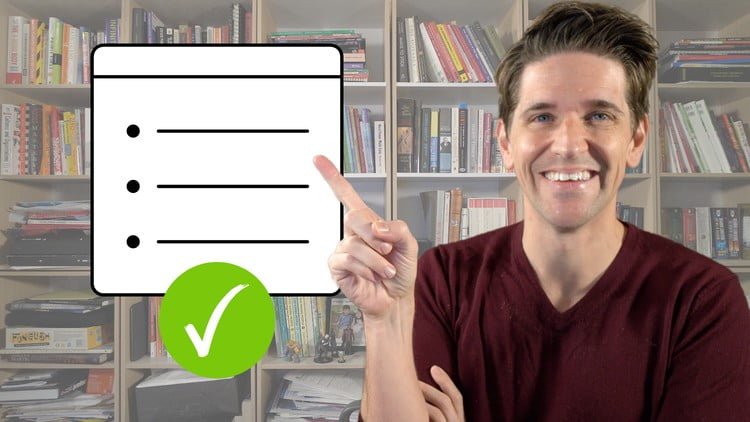- 030 244 2330
- info@preconceptacademy.com
Emergency Course for the TOEFL® iBT: Prep in Just 2 Days
- Description
- Curriculum
- FAQ
- Reviews
*** February 1st, 2022 updated***
Looking for a quick and simple guide to the new TOEFL exam?
You found it.
The TOEFL Emergency Course was designed to focus on the most important elements of the exam. By the end of the course, students will be able to predict the structure of each section of the exam and utilize exclusive strategies for answering all of the questions.
Most importantly, after going through the entire TOEFL Emergency Course, students will enter the exam feeling comfortable and confident in their TOEFL knowledge and skills.
Students who enroll in the course will gain access to:
- 5x hours of never-before-seen video lectures
- 1x Complete TOEFL test (with an answer key)
- 1x TOEFL Diagnostic test
- 1x Essential TOEFL Vocabulary List
- 10x additional TOEFL worksheets
And students will be able to go through all of the video content in just five hours. This course is a perfect fit for students who are new to the TOEFL, or for experienced TOEFL takers who are looking for a fresh approach to the test.
There are two types of TOEFL takers, those who get their score and those who do not. The ones that fail to reach their goal, regret their lack of preparation. Enroll today and walk in on TOEFL test day without any regrets.
-
1Introduction to the TOEFL Emergency CourseVideo lesson
Welcome to the TOEFL Emergency Course, where, in just five short hours, you will learn everything you need to know about the TOEFL. There is a lot of information to cover, but in this short introduction, we are going to take a closer look at the layout of the course and what you will be able to do by the end.
-
2The New TOEFL Test, August 1st, 2019Video lesson
-
3What to Expect from the CourseVideo lesson
In this course, you will first discover your current level with the TOEFL Diagnostic test, after that you are going to review the structure of the test, and then, finally, you will learn the best strategies to ensure your success on test day. This introduction video will help you get a better idea of how we are going to cover so much ground in so little time, and it will also be an opportunity for you to introduce yourself to me. That’s right, I want you to send me an email at contact@tstprep.com and it should say….
"Hi Josh, my name is ___ and I am ready to get my TOEFL score. I'm a little nervous about the ____ section, because ____. But I am ready to work hard and do whatever it takes to get my goal score of __"
-
4Creating Your TOEFL Study ScheduleText lesson
-
5The TOEFL Diagnostic TestVideo lesson
The TOEFL Diagnostic Test was designed for busy students like you who would like to have an idea of what their TOEFL score might be. It’s a 90-minute, condensed version of the exam to give you an immediate idea of your strengths, weaknesses, and what you need to do to improve. Some students feel like they are not ready for the test, but I assure you that you are. The sooner you take the test and confront your current ability level, the more likely you are to discover what you need to do to improve. Watch to learn more about the TOEFL Diagnostic Test.
Homework: Complete the TOEFL Diagnostic Test and check your answers. Reflect on your strengths, weaknesses, and what you need to do to improve (2x hours). If you would like a professional TOEFL teacher to check your speaking and writing, click this link to learn more. - https://tstprep.com/toefl-store/toefl-diagnostic-test/
-
6Homework: TOEFL Diagnostic TestText lesson
-
7First Steps in Your TOEFL Reading JourneyVideo lesson
This is a list of just a few of the things you will be able to do by the end of this short TOEFL Reading section: identify each reading question type, manage your time during the reading section, build TOEFL Reading vocabulary skills, learn from the best TOEFL vocabulary list, begin to read actively, use keywords to increase question answering speed, and discern between correct and incorrect choices. And we are going to do all of this in just 70 minutes. Let’s do it.
Homework: Look at the reading section of the diagnostic test and identify each question type. (15 minutes)
-
8The New TOEFL Reading Section, August 1st, 2019Video lesson
ETS, the company that creates the TOEFL, officially announced that there will be major changes to the TOEFL exam starting August 1st, 2019. And so, in this video, we are going to go over exactly what those changes are in the TOEFL Reading section, how it affects you, and what resources you can use to help prepare for this new TOEFL test.
-
9Homework: Identify Reading Question TypesText lesson
***I strongly recommend completing all homework assignments, but they are optional. The course will take you five hours to complete without the homework assignments, and about sixteen hours to complete with the homework assignments.
Homework: Look at the reading section of the diagnostic test and identify each question type. (15 minutes)
-
10TOEFL Reading Question TypesVideo lesson
Do you know all ten question types for the TOEFL Reading? If not, you need to watch this video. Each question type requires a different approach to answer. If you can not properly identify the question, it will be tough to answer. Watch this video and learn how to distinguish between all ten types of TOEFL Reading questions.
Homework: Look at the reading section of the complete TOEFL test and identify each question type. (45 minutes)
-
11Homework: Identify Reading Question Types, Part 2Text lesson
***I strongly recommend completing all homework assignments, but they are optional. The course will take you five hours to complete without the homework assignments, and about sixteen hours to complete with the homework assignments.
DOWNLOAD THE ATTACHMENT.
Homework: Look at the reading section of the complete TOEFL test and identify each question type. (45 minutes)
-
12Time Management for the TOEFL ReadingVideo lesson
In the TOEFL Reading, you have 60 minutes to read three texts, each approximately 700 words. You are also required to answer approximately 42 questions, about 14 per passage. If this sounds easy to you, I can assure you that it is not. It’s a demanding portion of the exam that requires your full attention. You have to go into this section with a specific strategy in mind if you expect to answer all the questions before time expires. Learn exactly how to manage your time to ensure that you answer every question in the TOEFL Reading.
Homework: Read through the Time Management handout. (15 minutes)
-
13Vocabulary and the TOEFL ReadingVideo lesson
Vocabulary questions are by far the most common in the TOEFL Reading, which is why you need a specific strategy to help you answer them. By the end of this lecture, you will know how to utilize word parts, eliminate choices, and avoid trap answers in the TOEFL Reading.
-
14The TOEFL Reading Section, Quiz 1Quiz
-
15The Best TOEFL Vocabulary ListVideo lesson
TOEFL Reading passages are academic texts. The words used in academic texts are different than the ones you might expect to read in a novel. You will use the Academic Word List to familiarize yourself with academic vocabulary that will most likely show up in the reading passages of the TOEFL. More importantly, you will learn how to use this list and study it at home with the power of flashcards.
Homework: Look through various flashcard apps and consider making flashcards to study vocabulary from the Ultimate TOEFL Vocabulary List. (30 minutes to research)
-
16How to Read ActivelyVideo lesson
Many TOEFL takers wonder the best way to improve their score. Most of the time, all they need is a different approach to studying for the test and thinking about the questions. Active reading is one of the best ways to help students re-conceptualize the TOEFL Reading in a way that has a dramatic impact on their overall comprehension. Follow this step-by-step guide to learn how to read actively.
Homework: Complete the Reading Actively handout. Check your summaries and compare them with the ones in the answer key. (1 hour)
-
17Homework: Reading ActivelyText lesson
-
18Using Key Words to Increase Speed and EfficiencyVideo lesson
Some words are more important than others. Performing well on the TOEFL Reading is not just about understanding what you read, but also identifying important information. Once you know what keywords are, you will be able to use them to find answers in the reading.
-
19Identifying Incorrect ChoicesVideo lesson
This is one of the most powerful lessons in the entire course. TOEFL test-makers create both correct and incorrect choices. Believe it or not, incorrect choices are more difficult to make than correct ones. In fact, there are a few common ways to craft an incorrect choice. Learning about these test patterns will help you spot incorrect options and lead you to the correct one on test day.
-
20The TOEFL Reading Section, Quiz 2Quiz
-
21Next Steps in Your TOEFL Reading JourneyVideo lesson
Congratulations on making it this far. You have come a long way. In this lecture, you will reflect on all you have learned in the reading section. For some, this introduction will not be enough. You still need more practice, strategy, and guidance. Watch to learn exactly where to go next.
-
22First Steps in Your TOEFL Listening JourneyVideo lesson
Congratulations on making it to the listening section of the TOEFL Emergency Course. This is a list of just a few of the things you will be able to do by the end of this short TOEFL Listening section: identify each listening question type, understand how to take effective notes, listen actively, figure out the main idea in any passage, record hard-to-remember information in your notes, and improve your listening focus. And we are going to do all of this in just 65 minutes. Let’s do it.
-
23The New TOEFL Listening Section, August 1st, 2019Video lesson
ETS, the company that creates the TOEFL, officially announced a few days ago that there will be major changes to the TOEFL exam starting August 1st, 2019. And so, in this video, we are going to go over exactly what those changes are in the TOEFL Speaking section, how it affects you, and what resources you can use to help prepare for this new TOEFL test.
-
24Homework: Identify Listening Question TypesText lesson
-
25TOEFL Listening Question TypesVideo lesson
There are eight different question types in the TOEFL Listening section. Do you know what they are? If not, this lesson is crucial. Learn to distinguish between each question type so you know how to respond to each on test day.
-
26Homework: Identify Listening Question Types, Part 2Text lesson
-
27Listening Actively and Finding the Main Idea, Part 1Video lesson
Most students believe they have to understand everything they hear in the listening passages. This simply isn’t true. It’s more important to find the main idea through active listening. How do you do it? In this lecture, you will discover the power of active listening and how to utilize this skill on test day.
-
28Homework: Listening ActivelyText lesson
-
29The Importance of the Main Idea, Part 2Video lesson
Two of the six passages in the listening section are conversations. In these dialogues, the main idea is usually the student’s problem. Once you identify the student’s problem, you get a better handle on the flow of the conversation and what information is important. This 5-minute lecture will teach you how to find the main idea in conversations.
-
30The Importance of the Main Idea, Part 3Video lesson
Four of the six passages in the listening section are lectures. Lectures can be a challenge because a professor will speak about an academic topic for up to five minutes. It’s tough to completely listen to anyone talk for five minutes straight, which is why you need to listen for one key piece of information, the main idea. Here you will discover how to think about the lectures in order to find the main idea, which, in turn, will make the questions much easier to answer.
-
31The TOEFL Listening Section, Quiz 1Quiz
-
32Note-taking for the TOEFL Listening, Part 1Video lesson
You have probably figured out by now that you have to take notes during the TOEFL exam, especially for the listening. However, you still may be a bit confused on how to do it. In this lecture, you will learn how to take notes like a North American college student. This skill will help increase the amount of content you understand and record on paper.
-
33Note-taking for the TOEFL Listening, Part 2Video lesson
Now that you have a method for taking notes (part one), it’s time to apply it. Here you will learn what you could, should, and must write down when listening to conversations. Your notes will not help much if the information is useless. Learn exactly what to listen for when taking notes during these audio passages.
-
34Note-taking for the TOEFL Listening, Part 3Video lesson
Listening to a five-minute lecture without breaking your concentration might be a challenge, which is why you must watch this next lecture. You will learn about the structure of the passage and the hierarchy of information you hear. This information will help organize both your thoughts and your notes.
-
35Homework: Practice Taking NotesText lesson
-
36Three Ways to Improve Your Listening FocusVideo lesson
Everyone loves a good listener, but how do you actually become one for the TOEFL? Train your eyes to focus only on the computer screen is one way. Another is to listen with a specific goal in mind. These are just a few of the tips you will learn to utilize to enhance your focus and listen with purpose on test day.
-
37The TOEFL Listening Section, Quiz 2Quiz
-
38Next Steps in Your TOEFL Listening JourneyVideo lesson
Congratulations on making it this far. You have come a long way. In this lecture, you will reflect on all you have learned in the listening section. For some, this introduction will be enough. For others, you may still need more practice, strategy, and guidance. Watch to learn exactly where to go next.
-
39First Steps in Your TOEFL Speaking JourneyVideo lesson
Congratulations on making it to the speaking section of the TOEFL Emergency Course. This is a list of just a few of the things you will be able to do by the end of this short TOEFL Speaking section: develop a growth mindset, understand the basics of the TOEFL Speaking grading criteria, learn the structure of all six questions, utilize a templated response for each question, organize your responses to align with time restrictions, score your own responses and shadow native speakers. And we are going to do all of this in just 90 minutes. Let’s do it.
-
40The New TOEFL Speaking Section, August 1st, 2019Video lesson
ETS, the company that creates the TOEFL, officially announced that there will be major changes to the TOEFL exam starting August 1st, 2019. And so, in this video, we are going to go over exactly what those changes are in the TOEFL Speaking section, how it affects you, and what resources you can use to help you prepare for this new TOEFL test.
-
41Your MindsetText lesson
-
42TOEFL Speaking Question 1, Part 1Video lesson
For every single TOEFL Speaking question, your goal is to sound natural and conversational. In this first of two lectures about speaking question number one, you will learn about the type of question to expect on test day. Further still, you will be provided with a word-for-word template that you can memorize and apply to almost any speaking question one. Once you understand the structure of the question and how you should respond, you will be able to walk in on test day feeling comfortable and confident with any TOEFL Speaking question one.
-
43TOEFL Speaking Question 1, Part 2Video lesson
After you have learned how the question will look and how you should respond, it’s time to actually prepare your own response. In this lecture, you will see a “perfect example” of a response to speaking question one that utilizes the template you learned in the previous lecture. After you see how to respond, it’s time for you to try it on your own. You will be provided with a scoring rubric to help you analyze your own recorded responses at home.
-
44TOEFL Speaking Question 2, Part 1Video lesson
For every single TOEFL Speaking question, your goal is to sound natural and conversational. In this first of two lectures about speaking question number two, you will learn about the type of question to expect on test day. Further still, you will be provided with a word-for-word template that you can memorize and apply to almost any speaking question two. Once you understand the structure of the question and how you should respond, you will be able to walk in on test day feeling comfortable and confident with any TOEFL Speaking question two.
-
45TOEFL Speaking Question 2, Part 2Video lesson
After you have learned how the question will look and how you should respond, it’s time to actually prepare your own response. In this lecture, you will see a “perfect example” of a response to speaking question two that utilizes the template you learned in the previous lecture. After you see how to respond, it’s time for you to try it on your own. You will be provided with a scoring rubric to help you analyze your own recorded responses at home.
-
46TOEFL Speaking Question 3, Part 1Video lesson
For every single TOEFL Speaking question, your goal is to sound natural and conversational. In this first of two lectures about speaking question number three, you will learn about the type of question to expect on test day. Further still, you will be provided with a word-for-word template that you can memorize and apply to almost any speaking question three. Once you understand the structure of the question and how you should respond, you will be able to walk in on test day feeling comfortable and confident with any TOEFL Speaking question three.
-
47TOEFL Speaking Question 3, Part 2Video lesson
After you have learned how the question will look and how you should respond, it’s time to actually prepare your own response. In this lecture, you will see a “perfect example” of a response to speaking question three that utilizes the template you learned in the previous lecture. After you see how to respond, it’s time for you to try it on your own. You will be provided with a scoring rubric to help you analyze your own recorded responses at home.
-
48The TOEFL Speaking Section, Quiz 1Quiz
-
49TOEFL Speaking Question 4, Part 1Video lesson
For every single TOEFL Speaking question, your goal is to sound natural and conversational. In this first of two lectures about speaking question number four, you will learn about the type of question to expect on test day. Further still, you will be provided with a word-for-word template that you can memorize and apply to almost any speaking question four. Once you understand the structure of the question and how you should respond, you will be able to walk in on test day feeling comfortable and confident with any TOEFL Speaking question four.
-
50TOEFL Speaking Question 4, Part 2Video lesson
After you have learned how the question will look and how you should respond, it’s time to actually prepare your own response. In this lecture, you will see a “perfect example” of a response to speaking question four that utilizes the template you learned in the previous lecture. After you see how to respond, it’s time for you to try it on your own. You will be provided with a scoring rubric to help you analyze your own recorded responses at home.
-
51The TOEFL Speaking Section, Quiz 2Quiz
-
52Next Steps in Your TOEFL Speaking JourneyVideo lesson
Congratulations on making it this far. You have come a long way. In this lecture, you will reflect on all you have learned in the speaking section. For some, this introduction will be enough. For others, you may still need more practice, strategy, and guidance. Watch to learn exactly where to go next.








